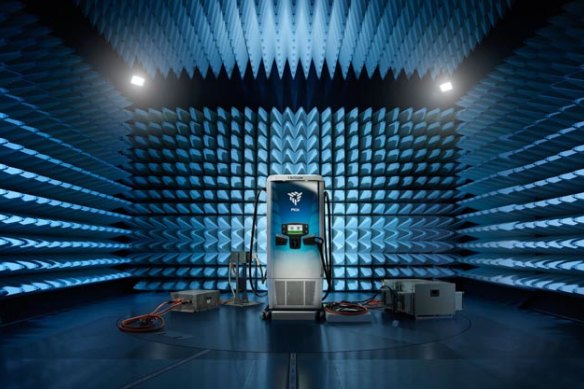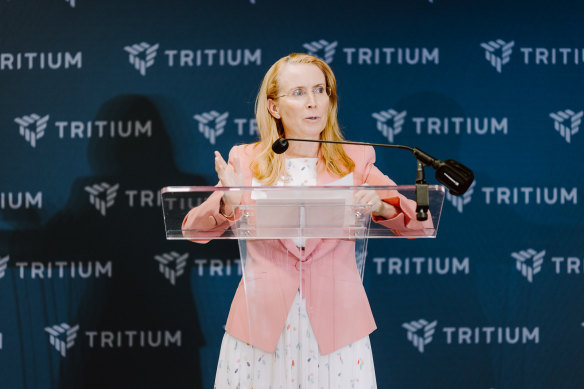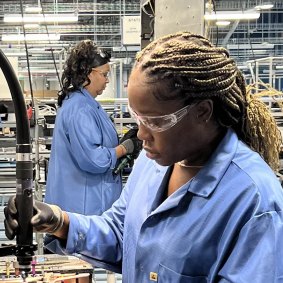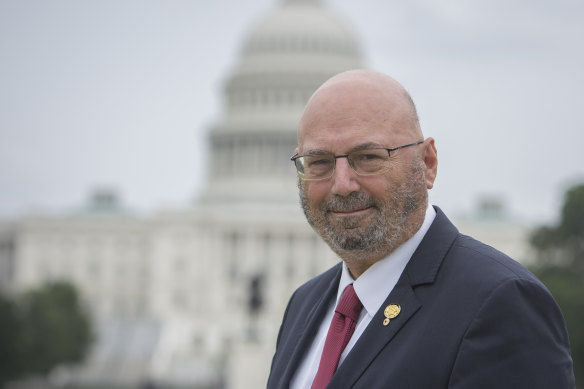The Australian charger company poised to ‘electrify’ US transportation
Lebanon, Tennessee: In a quiet Tennessee warehouse about 40 kilometres east of Nashville’s raucous honky-tonk bar precinct, an Australian company has found itself at the forefront of America’s ambitious climate change agenda.
Inside the walls of this sprawling blue building, a group of workers dressed in plastic protective coats are huddled along an assembly line, methodically connecting the components of an electric vehicle car charger that could revolutionise the way we drive.
Tritium’s new manufacturing facility in Lebanon, Tennessee will produce many of the company’s DC fast chargers, including the all-new PKM150 featured here.
Twenty years ago, Tritium was just a Brisbane based start-up with modest roots in solar racing and power electronics. Today, it’s a leading car charging manufacturer, deliberately choosing the US to expand its worldwide operations instead of Australia, which currently has one of the worst uptakes of electric vehicles in the world.
“Lots of people might have different views about climate change that can be very divisive,” Tritium chief executive Jane Hunter said today, as she opened the company’s largest American-based EV fast charger manufacturing facility in Lebanon, Tennessee.
“But from an economic perspective, the technology transition has happened. It’s here… and America has made this very smart decision to be a powerhouse in this new economy.”
Jane Hunter at the Tritium plant opening in the US.Credit:
The opening of the plant comes one week after President Joe Biden signed into law the so-called Inflation Reduction Act, which modelling suggests could help the US reduce greenhouse gas emissions by 40 percent from their 2005 levels.
Described by supporters as the most meaningful climate change bill ever passed in the US, the package commits about $US370 billion for environmental programs alone, including $US7500 tax credits for people who buy new electric cars, or $US4000 credits for used EV purchases.
Tritium’s decision to expand in the US also comes after Biden set an ambitious target for half the vehicles sold in the US to be electric or plug-in hybrids by 2030.
A production line worker assembles parts at Tritium’s new production plantCredit:Farrah Tomazin
However, to achieve this goal, the White House doesn’t just require more Americans to switch from petrol-guzzling cars – it also requires a network of hundreds of thousands of charging stations.
According to figures from McKinsey and Co, while sales of electric cars in the US have climbed by an average of 40 percent each year since 2016, nearly half of consumers say that battery or charging issues are their main concerns, which is discouraging prospective buyers.
To that end, it’s an exciting time for companies like Tritium, whose share of the EV fast charger market is now only second to China, says Hunter.
By the time the Tennessee plant is fully operational, its production lines are expected to make up to 30,000 electric vehicle DC (direct current) fast chargers a year – six times more than the 5000 units the company currently makes in Brisbane.
“The scale is absolutely phenomenal,” she says. “The chargers that we manufacture here are going to be installed on the highways in the US; at stores; at workplaces. They’re going to deliver on our vision of fast charging everywhere and make those long distances you want to travel in an EV as easy as filling up with gas.”
The opening of Tritium’s plant was welcomed by locals in Tennessee, a southern state well known for being the heart of America’s country music scene; the home of Elvis Presley’s Graceland; and the much-loved site of Dolly Parton’s Dollywood theme park.
But beyond the tourist attractions and lively music scene, Tennessee is also experiencing something of an EV boom: Volkswagen recently decided to spend close to $US800 million in Chattanooga to build its first electric vehicle; General Motors announced they would manufacture their flagship EV Cadillac in the state; and Nissan chose to set up its first manufacturing plant in Smyrna.
Among the many Americans who recently shifted from combustion engine vehicles to electric cars is Nashville local Jamal Jones, a 34-year-old Uber driver who owns a Model 3 Tesla. He says he charges his car about once a day, costing about $US15-20 for a full battery.
“That’ll last for about 339 miles,” he says, welcoming the news of a new player on the market. “The cars are great but you definitely need the charging stations.”
The opening of Tritium’s new plant comes as Australia also begins embracing electric vehicles more so than it has in the past.
Last week, the Albanese Labor government announced plans to release a discussion paper to develop a strategy aimed at expanding the range of new EV models in the country.
Electric vehicles currently represent about 2 percent of national car sales in Australia, resulting in the nation lagging behind much of the world.
However, Australia’s Ambassador to the US, Arthur Sinodinos, said the change of government had “upped the ante” in terms of climate change policy.
“When our new prime minister went to the Quad meeting in Tokyo just after the election, he said to President Biden that he wanted to make climate a third pillar of the (US-Australia) alliance,” said Sinodinos, as he helped cut the ribbon at today’s factory opening.
Australia’s ambassador to the US Arthur Sinodinos Credit:Sarah Baker
“We’ve got the ANZUS alliance, the military and security alliance which is increasingly important in today’s uncertain world; we’ve got trade and economic engagement… and we’ve now got climate as the third pillar of the alliance.
“This is just another example of how the US and Australia are working together.”
As for the company’s future in the US?
“Our mission is to electrify transportation,” says Mike Calise, Tritium’s president of the Americas, told The Age/Sydney Morning Herald.
“That’s all forms of electric transportation: two wheel, four wheel, passenger, fleet, marine, aviation… It’ll take a while for that to happen, but we do believe that we’re on a trajectory eventually to displace fossil fuels and meet those climate initiatives.”
Get a note directly from our foreign correspondents on what’s making headlines around the world. Sign up for the weekly What in the World newsletter here.
Most Viewed in World
From our partners
Source: Read Full Article



